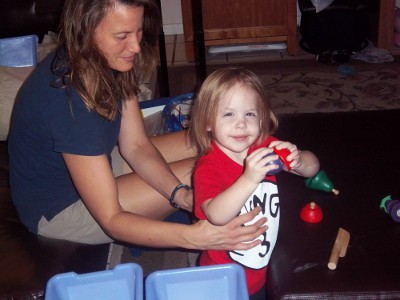Cranial Sacral Therapy

What is Cranial Sacral Therapy?
Cranial Sacral Therapy (CST) is a non-invasive form of therapy that helps the body to facilitate its own healing process by monitoring the health of the patient's nervous system. This technique uses light touch — usually no more than 5 grams of weight. The therapist feels the flow of the patient's craniosacral system, known as their craniosacral rhythm. This helps the therapist locate and correct restrictions in the body that causes the nervous system to be impaired. Used in conjunction with Sensory Integration Therapy or alone, Cranial Sacral Therapy can lay the groundwork for improved neurological functioning, processing and integration of sensory information.
What Is the Craniosacral System?
The craniosacral system gets its name from two areas of the body. Those two areas are the cranium, which consists of the skull that protect the brain, and the sacrum, which is the main bone at the base of the spine.
Inside the cranium, our brain floats in a fluid called cerebrospinal fluid (CSF). This fluid supports the central nervous system. It flows down our back through a sheath around our spinal cord, keeping the spinal cord lubricated.
What Can Go Wrong With the Craniosacral System?
Every day, your body endures stressors and strains that it must work to compensate for. Unfortunately, this stress often causes muscles and tissues to tighten, distorting the craniosacral system. These distortions can then cause tension to form around the brain and spinal cord resulting in restrictions. This can create a barrier to the healthy performance of the central nervous system, and potentially every other system it interacts with.
In addition to everyday wear and tear that everyone experiences, injury, birth trauma, and congenital defects can also have a very negative impact on the craniosacral system. All of this can cause the outer layers of the sheaths covering our brain and spinal cord to become tight and "kinked-up," just like muscles or tissue anywhere in the body.
This is a common issue and can contribute to all kinds of problems, including pain, numbness, dizziness, migraines, and conditions such as autism, sensory processing disorder, acid reflux, and high blood pressure.
How Does Cranial Sacral Therapy Help?
The goal of Craniosacral Therapy is to help the CSF to flow freely, and enable the spinal cord to move freely as well. To do this, CST works to remove restrictions in the craniosacral system. Having a freely flowing CSF will help us maintain our health and reduce or minimize pain, disease, and premature aging.
It is important to note, however, that when a restriction is released during a session, the effects are not always noticed at first. Sometimes it can take hours to weeks for the changes to be noticed. Sometimes the release can be quite intense. Sometimes the intensity can seem like a tantrum or even an SPD meltdown. This usually is when tissue memory is released.
Children sometimes after a release can be much calmer or have increased functioning in some skills. Typically the effects become more affective and profound with multiple sessions.
Once the craniosacral system has been balanced, healing can take place in a more efficient way, by supporting the body's natural power to heal.
What Conditions Does Cranial Sacral Therapy Address?
- Migraines and Headaches
- Chronic Neck and Back Pain
- Autism
- Stress and Tension-Related Disorders
- Motor-Coordination Impairments
- Infant and Childhood Disorders
- Brain and Spinal Cord Injuries
- Chronic Fatigue
- Fibromyalgia
- TMJ Syndrome
- Scoliosis
- Central Nervous System Disorders
- Learning Disabilities
- ADD/ADHD
- Post-Traumatic Stress Disorder
- Orthopedic Problems
- And Many Other Conditions
Are there any conditions that should NOT be addressed with CranioSacral Therapy?
There are a few situations in which CST is not recommended. They include any conditions in which slight variations in intracranial pressure would cause instability, such as acute aneurysm, recent skull fracture, and cerebral hemorrhage or other severe bleeding disorder. If you have any questions about whether these situations apply to you, seek the advice of your physician before receiving a CST session.
Have you tried this?
When my 4 year old was diagnosed with SPD at 18 months old, CST was suggested by her OT. I was slightly skeptical at first until I saw the amazing improvements it made in her. After 4 sessions, her craving to constantly drink from her sippy cup decreased by 40%. She also was not as sensitive to certain textures and smells as she used to be. Within a few months, she seemed to do a 180 with her behavior and SPD quirks. Still to this day she receives CST once a week. Now, she has almost all of her SPD quirks under control as well as scoring at a 7 year old level on her gross motor, fine motor, and cognitive abilities.
My youngest daughter also receives CST twice a week and has already started to show positive changes. Her meltdowns have decreased. She is still new to CST. She also started around 18 months of age with CST and is now 2.
Both girls thoroughly enjoy their sessions and look forward to them each week. It is very relaxing for them. There are times they do hit intense pieces. Those consist of screaming, crying and thrashing. But typically, they will go to sleep shortly after and always seem to feel much better after working on those types of pieces.
Would you suggest this?
I would highly recommend this form of therapy. I do not think my children would be where they are at today without this. This helped my children tremendously and they look forward to each session. I have heard of some children that it has been too intense for, but that is a small amount. Just remember that you know your child the best and can be the best at judging whether or not they can handle the therapy.